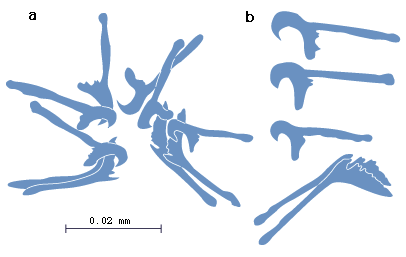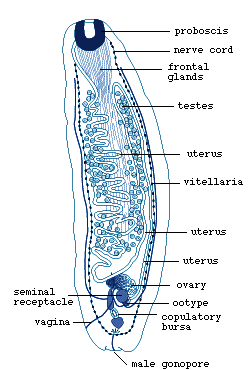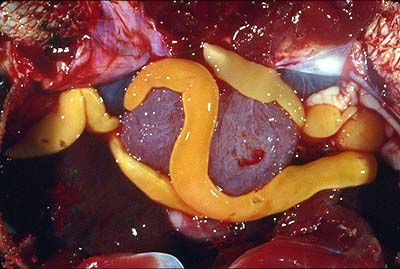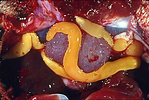Amphilinidea
Amphilinidae
Klaus Rohde


This tree diagram shows the relationships between several groups of organisms.
The root of the current tree connects the organisms featured in this tree to their containing group and the rest of the Tree of Life. The basal branching point in the tree represents the ancestor of the other groups in the tree. This ancestor diversified over time into several descendent subgroups, which are represented as internal nodes and terminal taxa to the right.

You can click on the root to travel down the Tree of Life all the way to the root of all Life, and you can click on the names of descendent subgroups to travel up the Tree of Life all the way to individual species.
For more information on ToL tree formatting, please see Interpreting the Tree or Classification. To learn more about phylogenetic trees, please visit our Phylogenetic Biology pages.
close boxPhylogeny of Amphilinidea (single family Amphilinidae)
(according to Bandoni and Brooks, 1987).
See section on synonyms for alternative
nomenclature.
Introduction
Only 8 amphilinid species are known. The amphilinids are large worms (several cm long) which, in contrast to the true tapeworms (Eucestoda), have a flattened leaf-like body that is not divided into proglottids (false "segments"). Larvae have 10 peculiarly shaped hooks of several types at the posterior end, which are retained by the adult. They are parasites in the body cavity of freshwater and marine teleost fishes and freshwater turtles (Dubinina, 1982). They have little economic significance, although one species was shown to affect sturgeon, the producers of caviar, adversely. Amphilinids are of considerable interest to biologists, because they may cast light on the phylogeny of tapeworms and of related forms. Most studies deal with the taxonomy as well as the light- and electron microscopic structure of a few species. Life cycles are known only for a few species and little is known of their effects on the host.
Characteristics
The Amphilinidea are large (several cm long), hermaphroditic, non-”segmented” flatworms whose adult stages live in the body cavity of turtles and teleost fish and use crustaceans as intermediate hosts. More detail is available on the Life cycles page. They have 10 hooks of several types at the posterior end (Fig.1), and a posteriorly located large seminal receptacle and ovary.


Figure 1. Hooks of larval Amphilina foliacea. a. Arrangement of hooks in the larva, b. Shape of hooks in greater detail (redrawn from Dubinina, 1982).
The uterus extends from the ovary to the anterior end, back again to the posterior end, and forward to open at the anterior end. Small follicular yolk glands and testes are scattered over large parts of the body. Amphilinids lack an intestine (Fig. 2).


Figure 2. Juvenile Amphilina foliacea. Note uterine opening at anterior end, and vaginal and male pores at posterior end (redrawn from Dubinina, 1982).
For more information see Structure of the larva and Structure of the juvenile and adult pages.
Discussion of Phylogenetic Relationships
Bandoni and Brooks (1987) have revised the Amphilinidea and made the first and only analysis of the group using phylogenetic systematics (cladistics). The analysis of 46 character states of 30 morphological (light-microscopic) characters produced the tree illustrated above. They distinguish three genera with altogether eight species, mainly based on the shape of the uterus (N-shaped or looped), shape of the body (elliptical, fusiform or elongate), whether vagina crossing or not crossing male duct, distribution of the testes and whether testes paired or not paired, whether vagina simple or bifurcate, shape of ovary, whether gonopore separate or common. Important characters, such as the structure of the protonephridial system, are not included, and the tree will almost certainly have to be revised using additional characters.
Gibson (1994) has given a key to the species (see also Schmidt, 1986), and Dubinina (1982), in her detailed monograph of the Amphilinidea, has discussed the position of the group in the phylum Platyhelminthes.
Synonyms
The genus and species names listed first are those from Dubinina (1982). They are used in the text, because they are supported by the best descriptions and widely used in the literature. The names proposed by Bandoni and Brooks (1987), which are used in the tree, are here marked with an asterisk.
- Amphilina foliacea*
- synonyms Monostomum foliaceum, Amphilina neritina
- Amphilina japonica*
- synonyms A. bipunctata, A. foliacea
- Gephyrolina paragonopora
- synonyms Amphilina paragonopora, Hunteroides mystel, Schizochoerus paragonopora*
- Schizochoerus liguloideus*
- synonyms Monostomum liguloideum, Amphilina liguloidea
- Nesolecithus janickii
- synonyms Amphilina liguloidea, Monostomum liguloideum, Schizochoerus janickii*
- Nesolecithus africanus
- synonym Schizochoerus africanus*
- Austramphilina elongata
- synonyms Kosterina Kuiperi, Gigantolina elongata*
- Gigantolina magna*
- synonyms Amphilina magna, Gyrometra albotaenia, Gyrometra kunduchi
References
Key References
For older references see Dubinina 1982.
Dubinina, M.N. (1982). Parasitic worms of the class Amphilinida (Platyhelminthes). "Nauka", Leningrad (in Russian). (Older references therein).
Gibson, D.I. (1994). Order Amphilinidea Poche 1922. In "Keys to the Cestode Parasites of Vertebrates" (L.F.Khalil, A.Jones and R.A. Bray, eds) CAB International. Wallingford, pp. 3-10.
Rohde, K. (1994). The minor groups of parasitic Platyhelminthes. Advances in Parasitology 33, 145- 234.
Other References
Andreev, V. V. and Markov, G. S. (1971). [Influence of some helminths on sturgeons]. Zoologicheskij Zhurnal 50, 15-24 (In Russian).
Bandoni, S. M. and Brooks, D. R. (1987). Revision and phylogenetic analysis of the Amphilinidea Poche, 1922 (Platyhelminthes: Cercomeria: Cercomeromorpha). Canadian Journal of Zoology 65, 1110-1128.
Baverstock, P. R., Fielke, R., Johnson, A. M., Bray, R. A. and Beveridge, I. (1991). Conflicting phylogenetic hypotheses for the parasitic Platyhelminthes tested by partial sequencing of 18S ribosomal RNA. International Journal for Parasitology 21, 329-339.
Bazitov, A. A. (1984). [Taxonomic relations of parasitic Platyhelminthes]. Zoologicheskij Zhurnal 63, 818-827 (In Russian).
Bazitov, A. A. and Lyapkalo, E. V. (1980). [Embryonic development of Amphilina japonica (Amphilinidea). I. Structure of the zygote and cleavage]. Zoologicheskij Zhurnal 59, 645-655 (In Russian).
Bazitov, A. A. and Lyapkalo, E. V. (1984). [Structure of the body wall and parenchyma of Amphilinida]. Zoologicheskij Zhurnal 63, 338-347 (In Russian).
Bazitov, A., Lyapkalo, A. and Yukhimenko (1979). [Spermatogenesis of Amphilina japonica (Goto et Ishii, 1936) (Amphilinidea)]. Vestnik Zoologi (Kiew) 1, 50-55 (In Russian).
Biserova, N.M., Dudicheva, V.A., Terenina, N.B., et al. (2000). The nervous system of Amphilina foliacea (Platyhelminthes, Amphilinidea). An immunocytochemical, ultrastructural and spectrofluorometrical study Parasitology 121, 441-453.
Brooks, D. R. (1982). Higher level classification of parasitic platyhelminths and fundamentals of cestode classification. In "Parasites: their world and ours", (D. F. Mettrick and S. S. Desser, eds). Elsevier Biomedical Press, pp. 189-193.
Brooks, D. R. (1989a). A summary of the database pertaining to the phylogeny of the major groups of parasitic platyhelminths, with a revised classification. Canadian Journal of Zoology 67, 714-720.
Brooks, D. R. (1989b). The phylogeny of the Cercomeria (Platyhelminthes: Rhabdocoela) and general evolutionary principles. Journal of Parasitology 75, 606-616.
Brooks, D. R., O'Grady, R. T. and Glen, D. R. (1985). The phylogeny of the Cercomeria Brooks, 1982 (Platyhelminthes). Proceedings of the Helminthological Society of Washington 52, 1-20.
Campos, A,, Cummings, M.P., Reyes, J.L., et al. (1998). Phylogenetic relationships of platyhelminthes based on 18S ribosomal gene sequences. Molecular Phylogenetics and Evolution 10, 1-10.
Coil, W. H. (1987a). The early egg of Austramphilina elongata (Cestodaria). Parasitology Research 73, 451-457.
Coil, W. H. (1987b). The oogenotop of Amphilina bipunctata (Cestodaria). Parasitology Research 73, 75-79.
Coil, W. H. (1991). Platyhelminthes: Cestoidea. In "Microscopic Anatomy of Invertebrates, Vol. 3: Platyhelminthes and Nemertinea", (F. W. Harrison and B. J. Bogitsh, eds). Wiley-Liss, New York, pp. 211-283.
Cole, N. C. (1968). Morphological studies on Cestodaria. M.A. thesis, University of California, Berkeley (cit. Simmons and Laurie, 1972).
Dubinina, M. N. (1976). [Platyhelminths of the class Amphilinoidea]. In "Problemy zoologii (Zool. Inst. A.N. SSSR)". Izdatel'stvo "Nauka", Leningrad, pp. 34-37 (In Russian).
Dubinina, M. N. (1978). Flatworms of the Amphilinida class (substantiation and system). 4th International Congress of Parasitology, Warsaw, Poland, Short Communications, Section B, 29-30.
Dubinina, M. N. (1982). "[Parasitic worms of the class Amphilinida (Plathelminthes)]". "Nauka", Leningrad (In Russian).(Older references therein).
Dubinina, M. N. (1985). [Class Amphilinidea]. In "Opredelitel' Parazitov Presnovodnykh Ryb Fauny SSSR", vol. 2 Paraziticheskie Mnogokletochnye (part 2), (O. N. Bauer, ed.). Nauka, Leningrad, pp. 388-394 (In Russian).
Dudicheva, V.A.and Biserova, N.M. (2000). [Distribution of sensory organs on surface of adult Amphilina foliacea (Plathelminthes, Amphilinida).] Zoologizheskij Journal 79, 1139-1146 (in Russian).
Ehlers, U. (1985). "Das phylogenetische System der Plathelminthes", Gustav Fischer, Stuttgart, New York.
Ehlers, U. (1986). Comments on a phylogenetic system of the Platyhelminthes. Hydrobiologia 132, 1-12.
Gibson, D.I. (1994). Order Amphilinidea Poche 1922. In "Keys to the Cestode Parasites of Vertebrates" (L.F.Khalil, A.Jones and R.A. Bray, eds) CAB International. Wallingford, pp. 3-10.
Gibson, D. I., Bray, R. A. and Powell, C. B. (1987). Aspects of the life history and origins of Nesolecithus africanus (Cestoda: Amphilinidea). Journal of Natural History 21, 785-794.
Hoberg, EP., Mariaux, J., Justine, J.L., et al. (1997). Phylogeny of the orders of the Eucestoda (Cercomeromorphae) based on comparative morphology: Historical perspectives and a new working hypothesis. Journal of Parasitology 83, 1128-1147.
Justine, J.L. (1997). The general classification of parasitic Platyhelminthes: recent changes, and the use of ultrastructural characters, particularly those of spermatozoa. Bulletin Soc. zool. France 122, 269-277.
Littlewood, D.T.J., Rohde, K., Bray, R.A. and Herniou, E.A.(1999). Phylogeny of the Platyhelmimthes and the evolution of parasitism. Biological Journal of the Linnean Society 68. 257-287.
Littlewood, D.T.J., Rohde, K. and Clough, K.A. (1999). The interrelationships of all major groups of Platyhelminthes - phylogenetic evidence from morphology and molecules. Biological Journal of the Linnean Society 66, 75-114.
Litvaitis, M.K. and Rohde, K. (1999). A molecular test of platyhelminth phylogeny: inferences from partial 28S rDNA sequences. Invertebrate Biology 118, 42-56.
Mariaux, J. (1998). A molecular phylogeny of the Eucestoda. Journal of Parasitology 84, 114-124.
Olson, P.D.and Caira, J.N. (1999). Evolution of the major lineages of tapeworms (Platyhelminthes : Cestoidea) inferred from 18S ribosomal DNA and elongation factor-1 alpha. Journal of Parasitology 85, 1134-1159.
Popova, L. B. and Davydov, V. G. (1988). Studies on localization of Amphilina foliacea (Amphilinidae Dubinina, 1974) in definitive hosts. Helminthologia 25, 129-138.
Rohde, K. (1986). Ultrastructural studies of Austramphilina elongata Johnston, 1931 (Cestoda, Amphilinidea). Zoomorphology 106, 91-102.
Rohde, K. (1987). The formation of glandular secretion in larval Austramphilina elongata (Amphilinidea). International Journal for Parasitology 17, 821-828.
Rohde, K. (1988). Phylogenetic relationship of free-living and parasitic Platyhelminthes on the basis of ultrastructural evidence. Fortschritte der Zoologie 36, 353-357.
Rohde, K. (1990b). Phylogeny of Platyhelminthes, with special reference to parasitic groups. International Journal for Parasitology 20, 979-1007.
Rohde, K. (1991). The evolution of protonephridia of the Platyhelminthes. Hydrobiologia 227, 315-321.
Rohde, K. (1994). The minor groups of parasitic Platyhelminthes. Advances in Parasitology 33, 145- 234.
Rohde, K. (2005). Amphilinidea. In: K.Rohde (ed.). Marine Parasitology. CSIRO Publishing, Melbourne and CABI Publishing, Wallingford, Oxon, 87-89, 461.
Rohde, K. and Garlick, P. R. (1985a). Two ciliate sense receptors in the larva of Austramphilina elongata Johnston, 1931, (Amphilinidea). Zoomorphology 105, 30-33.
Rohde, K. and Garlick, P. R. (1985b). Subsurface sense receptors in the larva of Austramphilina elongata Johnston, 1931, (Amphilinidea). Zoomorphology 105, 34-38.
Rohde, K. and Garlick, P. R. (1985c). Ultrastructure of the posterior sense receptor of larval Austramphilina elongata Johnston, 1931, (Amphilinidea). International Journal for Parasitology 15, 339-402.
Rohde, K. and Garlick, P. R. (1985d). A muticiliate 'starcell' in the parenchyma of the larva of Austramphilina elongata Johnston, 1931, (Amphilinidea). International Journal for Parasitology 15, 403-407.
Rohde, K. and Georgi, M. (1983). Structure and development of the larva of Austramphilina elongata Johnston, 1931 (Cestodaria, Amphilinidea). International Journal for Parasitology 13, 273-287.
Rohde, K., Hefford, C., Ellis, J., Baverstock, P.R., Johnson, A.M., Watson, N.A. and Dittmann, S. (1993). Contributions to the phylogeny of Platyhelminthes based on partial sequencing of 18S ribosomal DNA. International Journal for Parasitology 23, 705-724.
Rohde, K., Johnson, A.M., Baverstock, P.R. and Watson, N.A. (1995). Aspects of the phylogeny of Platyhelminthes based on 18S ribosomal DNA and protonephridial ultrastructure. Hydrobiologia 305, 27-35.
Rohde, K. and Watson, N. (1986a). Ultrastructure of spermatogenesis and sperm of Austramphilina elongata (Platyhelminthes, Amphilinidea. Journal of Submicroscopic Cytology 18, 361-374.
Rohde, K. and Watson, N. (1986b). Ultrastructure of the sperm ducts of Austramphilina elongata (Platyhelminthes, Amphilinidea). Zoologischer Anzeiger 217, 23-30.
Rohde, K. and Watson, N. (1987). Ultrastructure of the protonephridial system of larval Austramphilina elongata (Platyhelminthes, Amphilinidea). Journal of Submicroscopic Cytology 19, 113-118.
Rohde, K. and Watson, N. (1988). Development of the protonephridia of Austramphilina elongata. Parasitology Research 74, 255-261.
Rohde, K. and Watson, N. (1989). Ultrastructural studies of larval and juvenile Austramphilina elongata (Platyhelminthes, Amphilinidea); penetration into, and early development in the intermediate host, Cherax destructor. International Journal for Parasitology 19, 529-538.
Rohde, K. and Watson, N. (1990a). Ultrastructural studies of juvenile Austramphilina elongata. Transmission electron-microscopy of sensory receptors. Parasitology Research 76, 336-342.
Rohde, K. and Watson, N. (1990b). Ultrastructural studies of juvenile Austramphilina elongata.: scanning and transmission electron-microscopy of the tegument. International Journal for Parasitology 20, 271-277.
Rohde, K., Watson, N. and Garlick, P. R. (1986). Ultrastructure of three types of sense receptors of larval Austramphilina elongata (Amphilinidea). International Journal for Parasitology 16, 245-251.
Schmidt, G. D. (1986). "CRC Handbook of Tapeworm Identification". CRC Press, Inc., Florida.
Swiderski, Z. and Xylander, W.E.R. (2000). Vitellocytes and vitellogenesis in cestodes in relation to embryonic development, egg production and life cycle. International Journal for Parasitology 30, 805-817.
Xylander, W. E. R. (1986). Zur Biologie und Ultrastruktur der Gyrocotylida und Amphilinida sowie ihre Stellung im phylogenetischen System der Plathelminthes. Ph.D. Dissertation thesis, Göttingen.
Xylander, W. E. R. (1988). Ultrastructural studies on the reproductive system of Gyrocotylidea and Amphilinidea (Cestoda). I. Vitellarium, vitellocyte development and vitelloduct in Amphilina foliacea (Rudolphi, 1819). Parasitology Research 74, 363-370.
Xylander, W.E.R., Rohde, K. and Watson, N.A (1997). Ultrastructural investigations of the sensory receptors of Macrostomum cf bulbostylum (Plathelminthes, Macrostomida. Zoologischer Anzeiger 236, 1-12.
Zamparo, D., Brooks, D.R., Hoberg, E.P, et al. 2001). Phylogenetic analysis of the Rhabdocoela (Platyhelminthes) with emphasis on the Neodermata and relatives Zoological Scripta 30, 59-77.
Title Illustrations

| Scientific Name | Gigantolina elongata, Chelodina longicollis |
|---|---|
| Comments | Adult Austramphilina elongata in the body cavity of a long-necked turtle, Chelodina longicollis |
| Creator | photo by Russ Hobbs |
| Specimen Condition | Live Specimen |
| Image Use |
 This media file is licensed under the Creative Commons Attribution-ShareAlike License - Version 3.0. This media file is licensed under the Creative Commons Attribution-ShareAlike License - Version 3.0.
|
| Copyright |
© 1998 Klaus Rohde

|
About This Page
I would like to thank the following people for their assistance:- Computing: Maureen Heap
- Drawings: Lisa Donaldson, Louise Percival, Becky Francis, Sandy Hamdorf, and Sharon Molloy.
- Photos: Russ Hobbs
Klaus Rohde

University of New England, Armidale, New South Wales, Australia
Correspondence regarding this page should be directed to Klaus Rohde at
Page copyright © 1998 Klaus Rohde
 Page: Tree of Life
Amphilinidea. Amphilinidae.
Authored by
Klaus Rohde.
The TEXT of this page is licensed under the
Creative Commons Attribution License - Version 3.0. Note that images and other media
featured on this page are each governed by their own license, and they may or may not be available
for reuse. Click on an image or a media link to access the media data window, which provides the
relevant licensing information. For the general terms and conditions of ToL material reuse and
redistribution, please see the Tree of Life Copyright
Policies.
Page: Tree of Life
Amphilinidea. Amphilinidae.
Authored by
Klaus Rohde.
The TEXT of this page is licensed under the
Creative Commons Attribution License - Version 3.0. Note that images and other media
featured on this page are each governed by their own license, and they may or may not be available
for reuse. Click on an image or a media link to access the media data window, which provides the
relevant licensing information. For the general terms and conditions of ToL material reuse and
redistribution, please see the Tree of Life Copyright
Policies.
- First online 05 November 1998
Citing this page:
Rohde, Klaus. 1998. Amphilinidea. Amphilinidae. Version 05 November 1998. http://tolweb.org/Amphilinidea/20379/1998.11.05 in The Tree of Life Web Project, http://tolweb.org/








 Go to quick links
Go to quick search
Go to navigation for this section of the ToL site
Go to detailed links for the ToL site
Go to quick links
Go to quick search
Go to navigation for this section of the ToL site
Go to detailed links for the ToL site